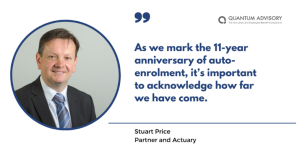This month marks the 11th anniversary of Automatic Enrolment (AE), first introduced in the UK in October 2012, following the Pensions Act of 2008.
But has it worked?
You don’t have to look too hard to find plentiful (and rather frightening) statistics around annual income needs in retirement for individuals to maintain a reasonable level of income. There are a few major issues to consider when it comes to meeting those needs – the decline in defined benefit (DB) pension schemes, insufficient contributions to defined contribution (DC) schemes and the ongoing sustainability of the state pension.
Minimum, moderate and comfortable living standards mean different things to different people of course but, according to a study by Loughborough University and the PLSA in January 2023, the required income in retirement is around £12,800 per annum at the lower end (minimum) and £37,000 per annum at the higher end (comfortable) for a single person, and £19,900 per annum (minimum), and £54,500 per annum (comfortable) for couples. The differences being at the minimum level the income received meets your absolute basic requirements (with no car and assuming a mortgage has been paid off) compared to the comfortable level of running a car, going on holiday and some disposable income – not huge extravagances. Worryingly, 70% of the population currently sit at achieving a minimum.
There are several means of accumulating income for retirement, state pension (through national insurance contributions), contributing to pension arrangements through an employer or a personal arrangement, ISAs, property (downsizing and using capital or rental income on a second property) inheritance and other savings – but many of these remain completely inaccessible to large portions of the population.
There is also real danger around perception of the state pension, many having an unrealistic expectation of what they will get, and a huge over reliance on it. For it to continue to exist at all, either the state pension age will need to increase, the amount received reduced, or contributions to it via national insurance increased. Further to this, the government can (and no doubt will) change these requirements at any time. The fact of the matter is that many people will have to work long past state pension retirement age.
In 2017 an AE review took place and six years later we are only now seeing the actions follow through from that. The two main ones being – contributions are to be based on the first pound of earnings rather than from the lower earnings limit of £6,240, and the contribution age will drop from 22 to 18. These changes will benefit over three million workers and bring half a million 18-21 year olds into saving for the first time. This is a good thing! And this younger age group can be more savvy. In fact, 86% of students are supportive of this change recognising that starting to save earlier will help them over a longer term.
So how well has AE really worked? As we approach the 11th year anniversary it’s important to acknowledge how far we have come, and, statistically speaking you can’t argue with its success. Before 2012, 50% were saving for retirement, post 2012 80% are saving – representing about 20 million people. That’s a huge number of people that are, at the very least, doing something. This can only be considered a good thing. Here comes the ….. BUT… there is so much more that needs to happen to ensure as many people as possible have a comfortable retirement, or a retirement at all.
So, what can we do? There are a few things that would make an impact:
- Scrap the £10,000 earning minimum for AE – have an ‘open door’ policy regardless of income so that lower earners can benefit from employer pension contributions.
- The self-employed – often have no pension provisions – having something automatically for them would help.
- Address the gender gap – an average man has a 35% better income than a female – that’s not right.
- Increase the 8% AE minimum total contribution (currently split 3% employer, 5% employee) to perhaps something like 12%.
- Could Collective Defined Contribution (CDC) pension arrangements be a good halfway house where risks are pooled among members and the benefits of economies of scale are delivered?
- Put resources behind engaging the lower paid – they will benefit the most.
Other drivers for change are:
- Financial Education – start in school – educate younger, make it a natural and simple part of the learning process. The more that is understood at a younger age the greater the chance of change.
- Employers supporting their employees – employers play a crucial role through workforce engagement. We encourage employers to highlight the pensions ‘good news’ story – the tax and national insurance reliefs on contributions and income, the employer contribution, flexibility before and in retirement – there is plenty of it!
- Dashboards have the potential to really change how the population engages with its retirement savings – it could be a really powerful awareness tool. It has been a real blow to see delay after delay with the latest one being to 2026.
Most people, later in life, wish they’d saved more – it’s right up there with ‘worry less’ and ‘eat the treats’. But seriously, small changes early on can make a huge difference later in life and it all boils down to awareness and education. As an industry we can help with this.
AE has, unarguably, been a great start but let’s expand on it to meet the challenges ahead.
Stuart Price, Partner, Quantum Advisory

